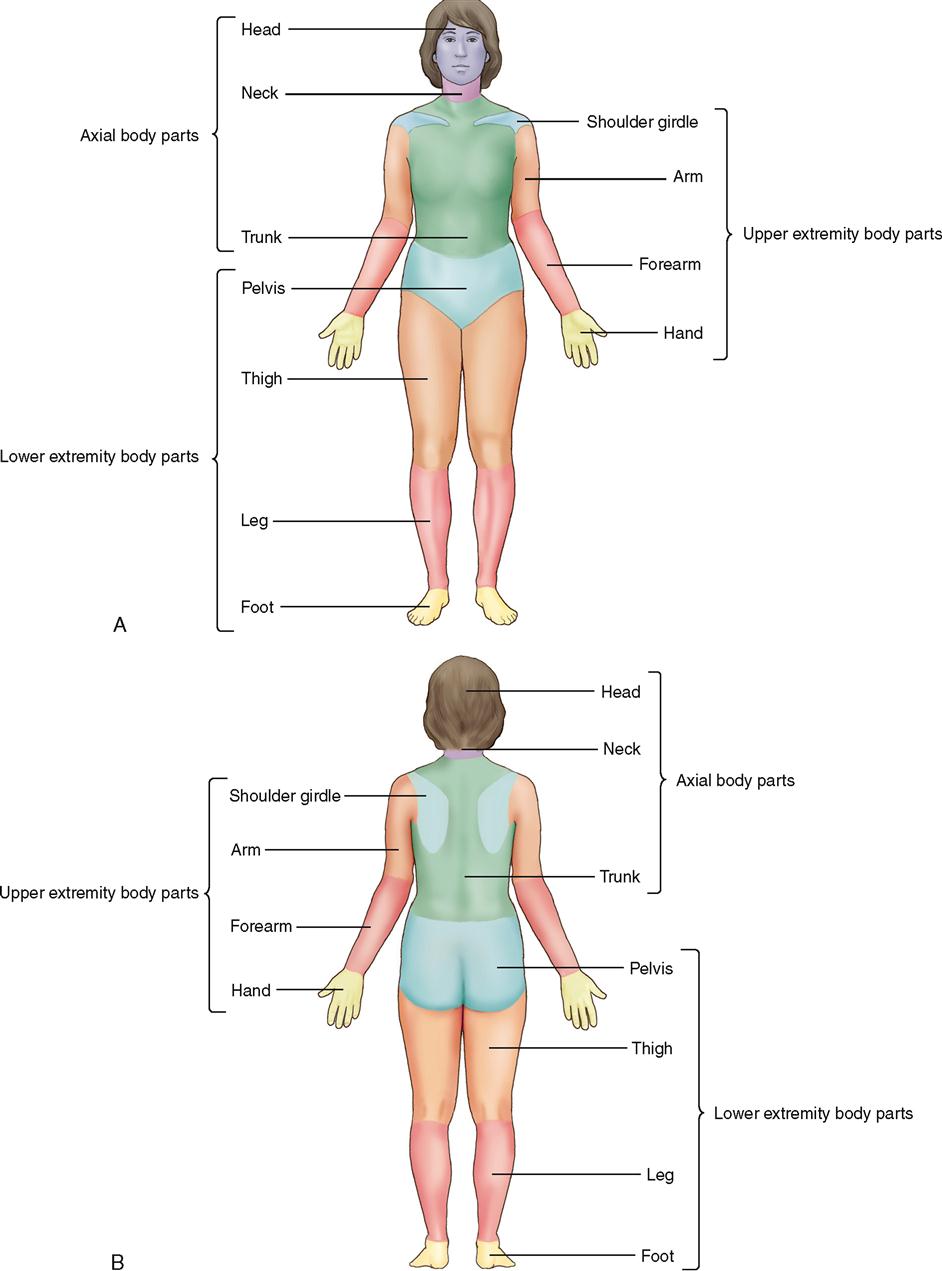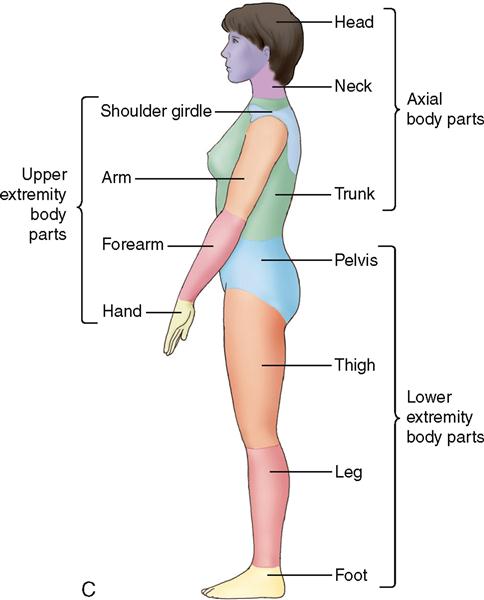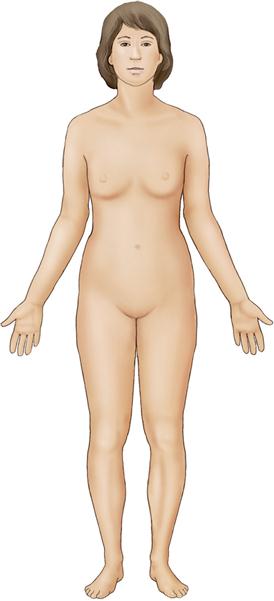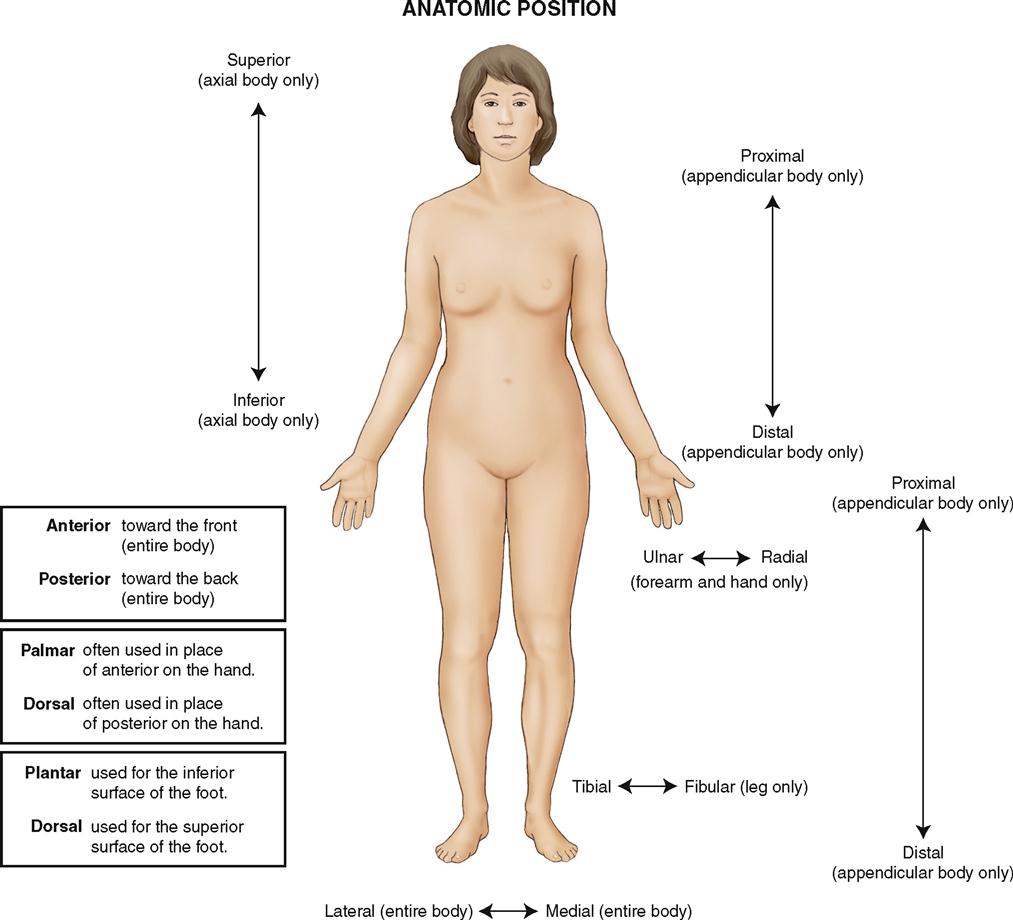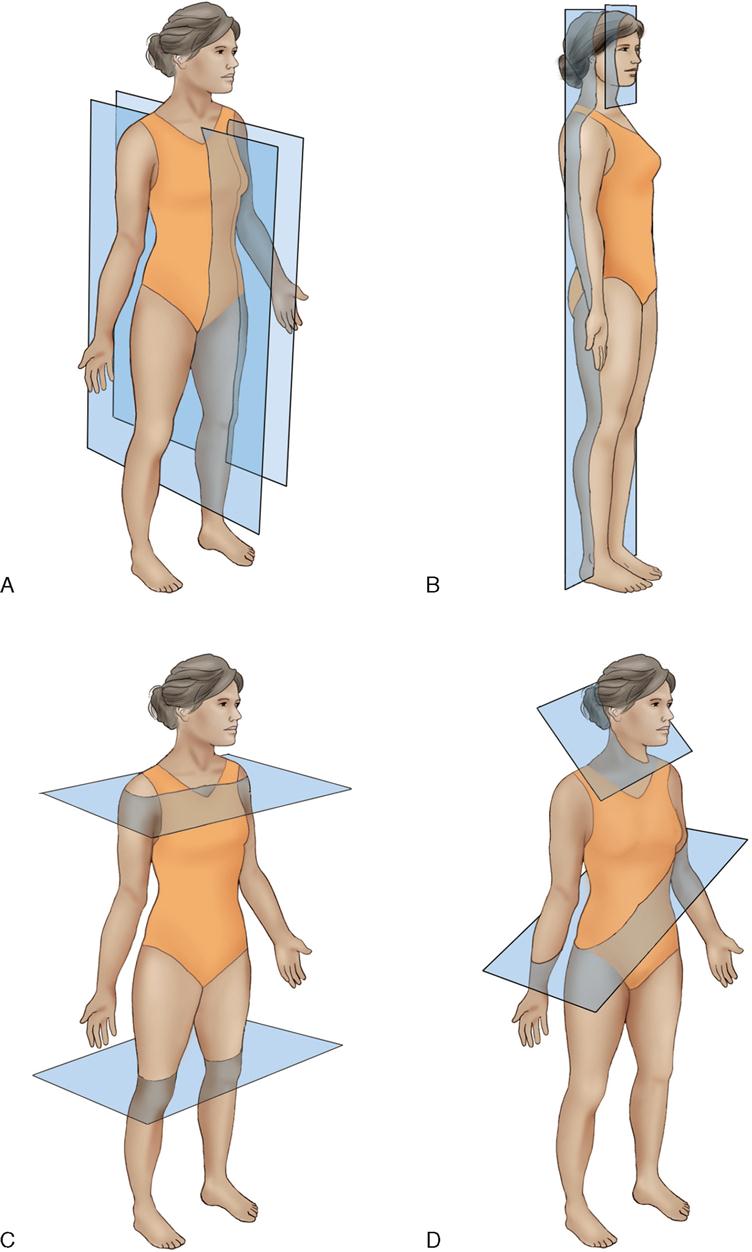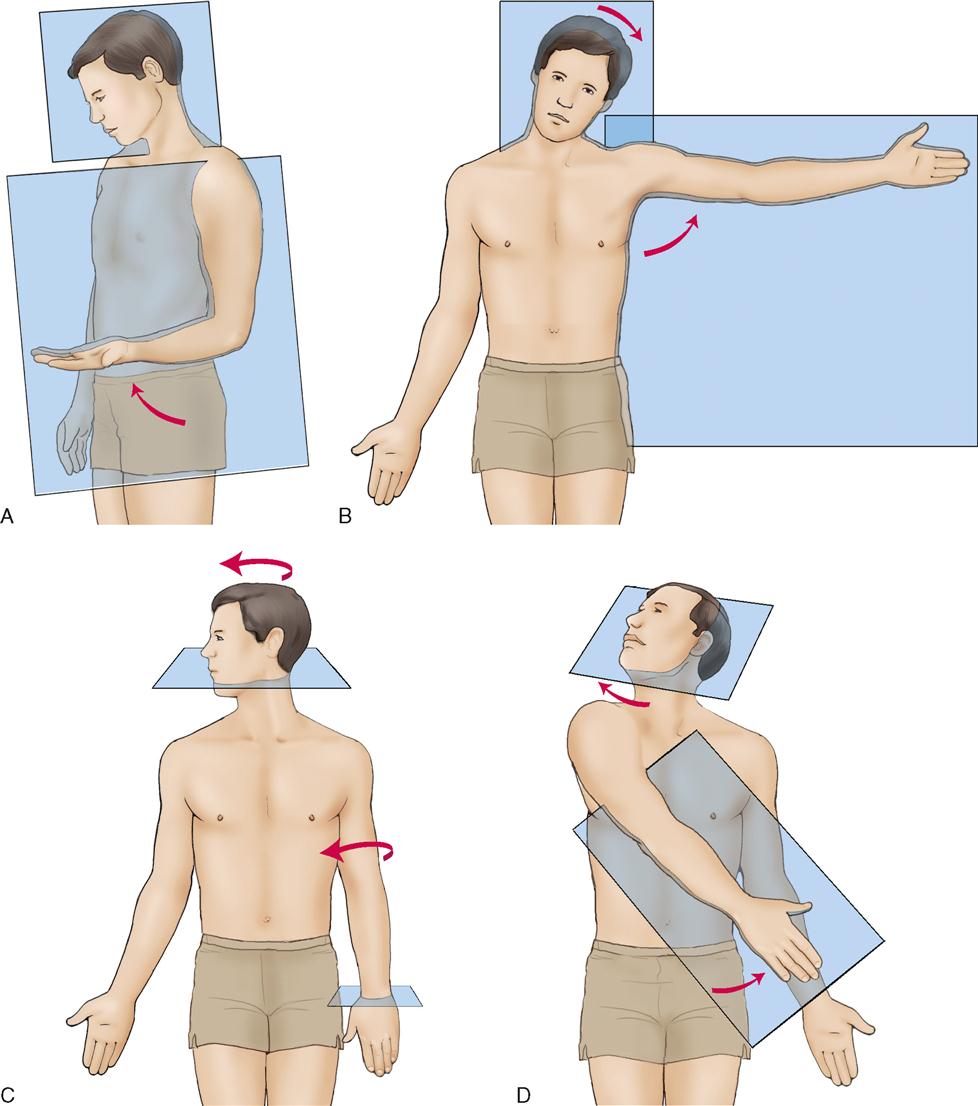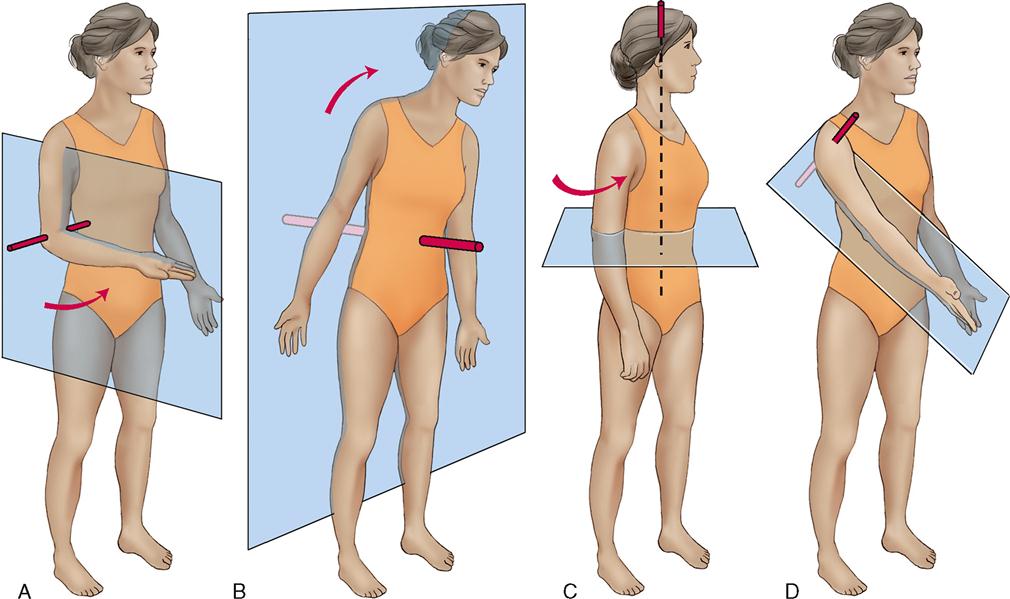Basic Kinesiology Terminology
Discussing muscle function without fluency in the language of kinesiology is not possible (Box 1-1). Specific kinesiology terms exist to help us avoid the ambiguities of lay language. Therefore embracing and using these terms is extremely important in the field of health care, where a person’s health depends on clear communication. The purpose of this chapter is to provide an overview of the basic terms of kinesiology. (For an in-depth and thorough discussion of the terminology of kinesiology, see Kinesiology: The Skeletal System and Muscle Function, 2nd edition [Elsevier, 2011].)
MAJOR BODY PARTS
Motions of the body involve the movement of body parts. To be able to describe the motion of body parts, each part must be accurately named. Figure 1-1 illustrates the major divisions and body parts of the human body. The axial body and the appendicular body are the two major divisions. The appendicular body can be divided into the upper and the lower extremities.
The names of most body parts are identical to the lay English names. However, a few cases exist where kinesiology terms are very specific and need to be observed. For example, the term arm is used to refer to the region of the upper extremity that is located between the shoulder and elbow joints. The term forearm refers to the body part that is located between the elbow and wrist joints; the forearm is a separate body part and is not considered to be part of the arm. Similarly, the term leg describes the region of the lower extremity that is located between the knee and ankle joints, whereas the term thigh is used to describe an entirely separate body part that is located between the hip and knee joints; the thigh is not part of the leg. The precise use of these terms is essential so that movements of the leg and thigh are not confused with one another, and movements of the arm and forearm are not confused with one another. Pelvis is another term that should be noted. The pelvis is a separate body part from the trunk and is located between the trunk and thighs.
ANATOMIC POSITION
Anatomic position is a standard reference position that is used to define terms that describe the physical location of structures of the body and points on the body. In anatomic position, the person is standing erect, facing forward, with the arms at the sides, the palms facing forward, and the fingers and toes extended (Figure 1-2).
LOCATION TERMINOLOGY
Now that anatomic position has been defined, it can be used as the reference position for location terms that describe the relative locations of body parts, structures, and points on the body to each other. Location terminology is made up of directional terms that come in pairs, each member of the pair being the opposite of the other.
Pairs of Terms
Anterior/Posterior
Anterior means farther to the front; posterior means farther to the back. These terms can be used for the entire body, axial and appendicular.
Medial/Lateral
Medial means closer to an imaginary midline that divides the body into the left and right halves. Lateral means farther from this imaginary midline. These terms can be used for the entire body, axial and appendicular.
Superior/Inferior
Superior means above (toward the head). Inferior means below (away from the head). These terms are usually used for the axial body only.
Proximal/Distal
Proximal means closer (i.e., more proximity) to the axial body; distal means farther (i.e., more distant) from the axial body. These terms are only used for the appendicular body.
Superficial/Deep
Superficial means closer to the surface of the body. Deep means farther from the surface of the body (i.e., more internal). These terms can be used for the entire body, axial and appendicular.
Radial/Ulnar
The terms radial and ulnar can be used for the forearm and hand in place of the terms lateral and medial, respectively. The radius is the lateral bone of the forearm; the ulna is the medial bone.
Tibial/Fibular
The terms tibial and fibular can be used for the leg and sometimes the foot in place of the terms medial and lateral, respectively. The tibia is the medial bone of the leg; the fibula is the lateral bone.
Palmar/Dorsal
The terms palmar and dorsal can be used for the hand in place of the terms anterior and posterior, respectively.
Plantar/Dorsal
The terms plantar and dorsal can be used for the foot. The plantar surface of the foot is the undersurface that is planted on the ground. The dorsal surface is the top or dorsum of the foot.
Cranial/Caudal
Cranial means toward the head; caudal means toward the “tail” of the body. These terms are only used for the axial body.
Combining Terms of Location
Similar to combining terms such as north and west to create northwest, location terms can be combined. When doing this, the end of the first word is usually dropped, and the letter o is placed to connect the two words. For example, anterior and lateral combine to become anterolateral. Although no hard and fast rule exists, anterior and posterior are usually placed first when combined with other terms. Figure 1-3 is an anterior view of a person, illustrating the terms of relative location as they pertain to the body.
PLANES
Planes are flat surfaces that cut through and can be used to map three-dimensional space. Because space is three-dimensional, three major planes, known as cardinal planes, exist. The three cardinal planes are (1) sagittal, (2) frontal, and (3) transverse planes (Box 1-2). The sagittal plane divides the body into left and right portions. The frontal plane divides the body into front and back (anterior and posterior) portions. The transverse plane divides the body into upper and lower (superior and inferior or proximal and distal) portions. Each of these three cardinal planes is perpendicular to the other two planes. Any plane that is not perfectly sagittal, frontal, or transverse is described as an oblique plane. Therefore an oblique plane has components of two or three cardinal planes. Figure 1-4 illustrates two examples each of the three cardinal planes and an oblique plane.
Motion of the Body within Planes
Planes become extremely important when we describe the motion of a body part through space, because the body part moves within a plane. Hence, by defining the planes of space, we can describe the path of motion of a body part when it moves. Note that the sagittal and frontal planes are vertical and the transverse plane is horizontal. Therefore motions within the sagittal and frontal planes move vertically up and down and motions within the transverse plane move horizontally. Figure 1-5 illustrates examples of motion within the three cardinal planes and an oblique plane.
AXES
An axis (plural: axes) is an imaginary line around which a body part moves. If a body part moves in a circular path around an axis, it is described as an axial motion. If the body part moves in a straight line, it is described as a nonaxial motion. Both axial and nonaxial motions of a body part move within a plane. However, an axial motion moves within a plane and moves around an axis. The orientation of an axis for movement is always perpendicular to the plane within which the movement is occurring.
Each plane has its own corresponding axis; therefore there are three cardinal axes. The axis for sagittal plane movements is oriented side to side and described as the mediolateral axis, the axis for frontal plane movements is oriented front to back and described as anteroposterior, and the axis for transverse plane movements is oriented up and down and described as superoinferior or simply vertical. Each oblique plane also has its own corresponding axis, which is perpendicular to it. Figure 1-6 illustrates axial motions that occur within planes and around their corresponding axes.
Stay updated, free articles. Join our Telegram channel

Full access? Get Clinical Tree



